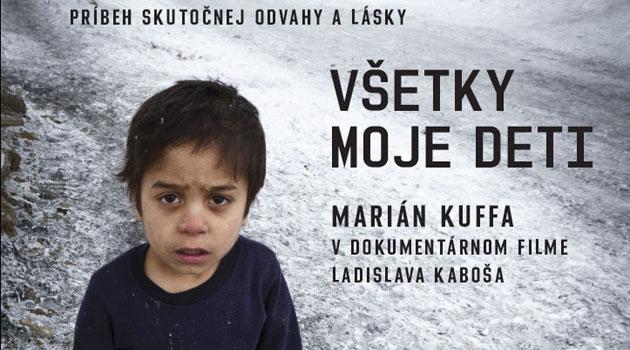"All My Children" (Všetky moje deti), a documentary by Slovak director Ladislav Kaboš, captures the charismatic priest Marián Kuffa and the unusual aid he provides to Romani people. His aim is not to give them what they lack free of charge, but to teach them to help themselves.
Kuffa endeavors to teach Romani people how to build themselves homes, how to rid themselves of their hopeless dependency on the state, and how to find their lost self-awareness and self-respect. The 90-minute film was made in the Romani settlements of Huncovce and Velká Lomnice in the foothills of the Tatra mountains over the course of three years.
The film premiered in Slovakia on 13 February, and during just one month had already been seen by 17 280 viewers. In its first 10 days alone it became the most successful documentary film of Slovak cinema ever in terms of ticket sales.
"All My Children" has refuted the myth that documentaries don’t belong in the repertoire of multiplex cinemas. The successful film has been nominated for the East Silver Eye prize and has been available in Czech cinemas since 13 March.
"Love people according to their needs, not their merits," says Marián Kuffa, who is a priest, an agricultural engineer and a former mountain climber. He has been working for more than 25 years in Žakovce in Slovakia, where he has built a community based on Christianity literally out of nothing, bringing together people who are social outcasts – convicts, drug addicts, and prostitutes.
Together these people have built a prospering business involving not just agriculture and livestock production, but also caring for the mentally disabled. Recently Kuffa’s interest has turned to the many other Romani settlements in Slovakia that are socially excluded.
The film brings viewers into one of an estimated 150 such Romani settlements in the country. The first images are shocking.
The cardboard huts in which these families live with their children are located almost exactly in the middle of a junkyard full of rats. Disharmony is apparent at first glance.
Beátka, a young mother, tells us how the rats bother her family and have even bitten her child. A micro-world is presented to us in which we are not aware of moving from one settlement to another – it is as if Huncovce and Velká Lomnice were fused into a single settlement, as if the director wanted to tell us how very similar life in one socially excluded locality is to life in any other.
Surviving in these places often means fighting for one’s bare life. There is nothing to eat, the children have no clothes, and in order for the Roma to find fuel they risk six-month prison sentences for trespassing in the forest.
In the documentary we witness genuine arguments, battles, First Communion celebrations and mourning over the passing of two children who burn to death in one of the huts. We learn of the protagonists’ desires and fantasies about life, which are not so different from our own.
The settlement residents want to live at a certain level, to be accepted without prejudice, and they want a better future for their children. "It’s very easy to say the Roma should work. Will you take a Rom in? Will you invite him into your garden, into your home? Who will take him in?" Kuffa asks in the film.
At another point the priest calls on businesses who employ Romani people to contact him. Director Ladislav Kaboš approaches the topic without any delusions, pathos, or prejudice.
Behind this precise, sensitive documentary work a deep effort is visible to present as faithful an image as possible of life in the settlements and of the regenerative process being led by Marián Kuffa in all its variety. That is precisely what I consider the most valuable thing about the film.
The overall result is also significantly assisted, in my opinion, by the very fortunate selection of the protagonists whose fates we follow over the three years. We get to know the young Beátka, who comes to the settlement after growing up in an orphanage and establishes a family there.
We meet Zdena, whose life is deeply affected by his seriously ill wife. We also look into the family of Romani leader Stanislav Čonka and others.
Collaboration between the settlement of Žakovce and the surrounding Romani settlements is essential. In a brief speech given before the premiere of the film at Prague’s Lucerna cinema, Stanislav Čonka clarified that there are a total of nine Romani settlements with whom Kuffa and the residents of Žakovce cooperate.
Building materials from demolition sites are gathered by Kuffa’s "guys" from Žakovce. Many brightly colored little houses then spring up throughout the Romani settlement, built by the residents themselves.
Above the front door of each house hangs a sign with a few words from the prayer "Hail Mary", with the last house providing the final "Amen". One of the film’s closing scenes is that of a community celebration.
This scene, in which the Roma present their program to a pleased, surprised, and touched local audience comprised of all of the residents of the parish, including the convicts and the mentally disabled, is one of the strongest in the film. Marián Kuffa dances and smiles with satisfaction, everyone is together, and for a moment, everyone is happy.
Each year of the film is separated from the next by wintertime footage of the road leading into the Romani settlement. That road leads somewhere, there is hope for a better life along it, and it leads as well to the question: What will happen next?
